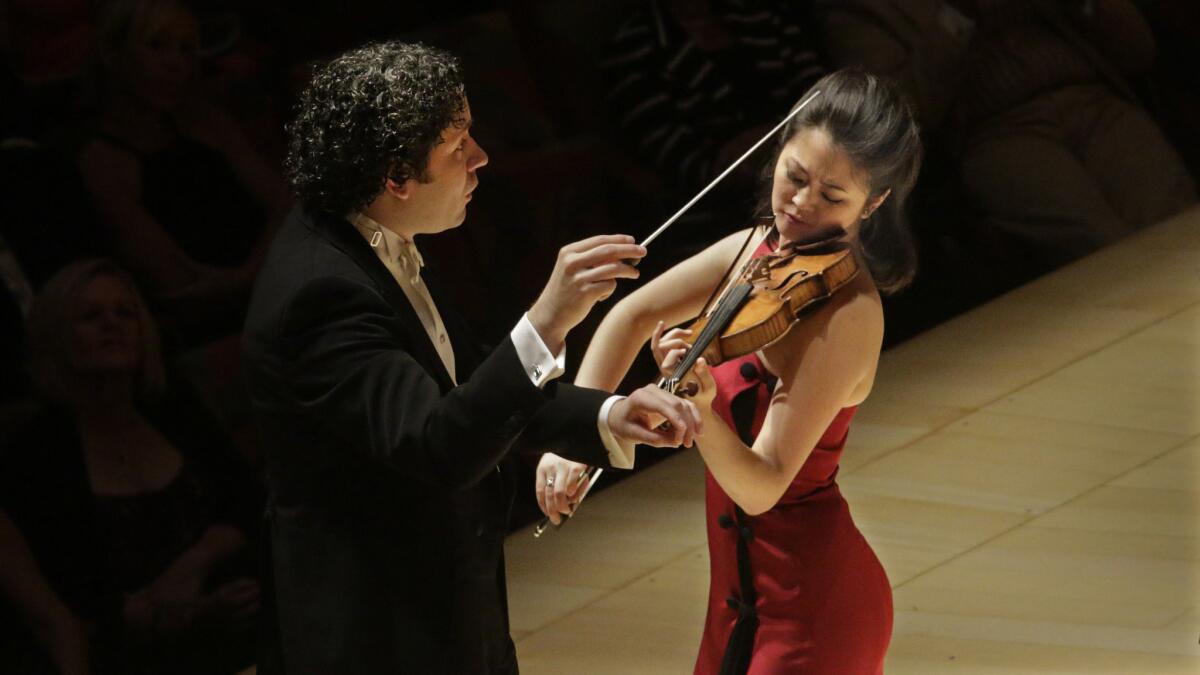Review: L.A. Phil digs into early Beethoven, explores what is immortal

Gustavo Dudamel conducting the Los Angeles Philharmonic with violinist Simone Porter in Beethoven’s Romance No. 2.
- Share via
The Los Angeles Philharmonic is calling its cycle of Beethoven’s nine symphonies, which Gustavo Dudamel began Thursday night at Walt Disney Concert Hall, “Immortal Beethoven.” That may not be an exaggeration. So far, at least, Beethoven’s symphonies do not die.
It is now 215 years since a 30-year-old Beethoven made a splash in Vienna with the premiere of his First Symphony. At the Upbeat Live preconcert talk Thursday, Jan Swafford — author of the impressive recent biography “Beethoven: Anguish and Triumph” — pointed out that the symphonies are Beethoven’s most public statements. And the public has never stopped embracing them.
In fact, Beethoven symphony performances have become all but inescapable. Besides Dudamel’s Beethoven symphony cycle, the Utah Symphony began one last month and the Minnesota Symphony launches a cycle on New Year’s Eve. Simon Rattle is in the midst of a sold-out series with the Berlin Philharmonic, which he will bring to Carnegie Hall in November.
SIGN UP for the free Essential Arts & Culture newsletter >>
It is a rare orchestra anywhere that will not play at least one Beethoven symphony this season. In Southern California, we have a Beethoven freeway series this weekend, since the Pacific Symphony began its new season in Costa Mesa on Thursday with the first of four performances of Beethoven’s Ninth.
So what does it all mean? Why Beethoven? Why now?
The most banal answer is that Beethoven is box office. The composer has become synonymous with genius, up there in the popular imagination with Steve Jobs and Einstein. Critic Robert Lloyd noted in his Times review of the new television series “Rosewood” that the protagonist is a medical examiner who likes to be is considered “the Beethoven of private pathologists.”
But private pathologists are no more immortal than the tissues they examine. What keeps the Beethoven symphonies alive is, as Swafford also remarked, that they represent one of the most remarkable journeys, stylistically and spiritually, in the history of music. The symphonies are just abstract enough and just specific enough, just mundane enough and just spiritual enough, to offer the experience of a pilgrim’s progress through troubles and into transcendence.
A Beethoven symphony cycle is then a timeless human ritual, and what makes Dudamel’s cycle uncommon is that the symphonies are being performed in order. That is hardly ever done for the simple reason that each concert is a full price ticket, and thus each concert needs at least one meaty symphony. Dudamel, moreover, will be dividing the symphonies between the L.A. Phil and the Simón Bolívar Symphony Orchestra of Venezuela (with both orchestras combined for the Ninth).
All of that made Thursday’s opener of the early First and Second symphonies with the L.A. Phil a relatively modest affair rather than a reliable indication of what will follow in this cycle. Written for a small orchestra, the first symphonies begin to expand on the agreeable classical symphonic model of Haydn. With the Third (the “Eroica”), Beethoven exploded that model into something radically new and powerful.
The fashion, these days, is to connect these early symphonies with the past, performing them with the smallish-sized ensembles that were available to Beethoven at the time, all the better to reveal the individual ways in which Beethoven’s dominating personality was revealed.
Dudamel relied on more strings than Beethoven would have had on hand, although the orchestra was nevertheless reduced to a chamber band. But Dudamel’s approach was to dig deep into what made Beethoven. He made no attempt to have modern instruments mimic the tart sounds of older ones (the timpani were, though, period).
The textures of the L.A. Phil were luxuriant, the playing smooth and gorgeous. Balances were exquisitely handled. Tempos were slower than what Beethoven asked for (his insanely fast metronome markings are controversial, since they were added after the composer had become deaf).
Thus instead of being a Doctor Who who would take us to the beginning of the 19th century, Dudamel looked at the symphonies from the perspective of already knowing the monumentality Beethoven would soon achieve and exploring where that came from. There was no false innocence, no belief that the shock of the new is renewable.
In the First Symphony, harmonies that might once have startled now had a rich expressivity verging on world-weariness. The Andante was less gentlemanly gavotte than wistful dance. But gripping propulsion and rhythmic élan supplied excitement to the outer movements.
The more substantial Second Symphony lost some of its playfulness. Beethoven was at the early, freaked-out stage of coming to terms with his impending deafness, and the high-spirited Second can be heard as an essay in denial. Dudamel made it tight, touching and, in the Scherzo and Finale, powerful.
Innocence was reserved for elsewhere. Dudamel filled out the program with Beethoven’s two violin romances. These pleasingly sweet slow movements for violin and orchestra were played by Simone Porter, a 19-year-old student at the Colburn Conservatory. Her assured, lovingly lyrical, occasionally frisky playing only confirmed what is becoming common knowledge in the musical world: that she is on the cusp of a major career.
Follow me on Twitter @markswed
------------
Los Angeles Philharmonic and Simón Bolívar Symphony Orchestra Beethoven Symphony Cycle
Where: Walt Disney Concert Hall, downtown Los Angeles
When: Through Oct. 11.
Cost: $26.50 – $213.50
Info: (323) 850-2000, www.laphil.org
More to Read
The biggest entertainment stories
Get our big stories about Hollywood, film, television, music, arts, culture and more right in your inbox as soon as they publish.
You may occasionally receive promotional content from the Los Angeles Times.











